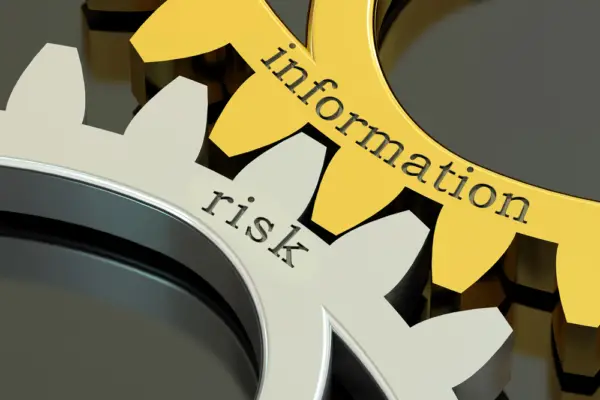Measured risk refers to the quantification of the potential for loss or negative outcomes in an investment, project, or any business-related activity.
It involves using statistical methods and historical data to estimate the likelihood and impact of various adverse events. Quantifying risks allows for informed decision-making by individuals and organizations.
In finance, measured risk is typically assessed using the risk metrics mentioned previously, such as Value at Risk (VaR), Expected Shortfall (ES), beta, standard deviation, Sharpe Ratio, and maximum drawdown.
These metrics help investors and analysts understand the volatility of an asset, its correlation with the market, and the potential for losses, which are critical for portfolio construction and risk management strategies.
In a business context, measured risk might involve evaluating the potential for supply chain disruptions, cybersecurity breaches, market shifts, or changes in regulatory environments.
Risk Assessment” href=”https://riskpublishing.com/how-to-conduct-a-risk-assessment/”Risk Assessment” href=”https://riskpublishing.com/how-to-conduct-a-risk-assessment/”>>Risk assessments can inform business continuity planning, cybersecurity measures, strategic planning, and compliance management.
Measured risk involves assessing the potential risks associated with a particular action or investment, allowing individuals and organizations to make informed choices.

But what exactly is measured risk? How is it calculated? And what factors should be taken into consideration? In this discussion, we will explore the definition of measured risk, its importance in decision-making, the various statistical measures used, and real-life applications.
Understanding measured risk is essential for anyone looking to navigate the complexities of risk management and make sound, calculated decisions. So, let’s dive into this intriguing topic and uncover its secrets together.
Key Takeaways
- Measured risk is crucial for making informed decisions, managing uncertainties, and developing robust risk management strategies.
- It helps in assessing potential risks, prioritizing actions, and allocating resources appropriately.
- Measuring risk aids in understanding exposure to different risks, determining risk levels in a portfolio, and calculating potential risks.
- Lack of understanding in risk measures can lead to detrimental consequences, while incorporating measured risk minimizes potential risks in decision-making.
Definition of Measured Risk
Measuring risk is crucial in making informed decisions and managing uncertainties effectively. By quantifying and assessing the potential impact and likelihood of various risks, organizations can prioritize their actions and allocate resources appropriately.
Understanding the definition of measured risk allows businesses to develop robust risk management strategies and minimize potential losses or disruptions to their operations.
Importance of measuring risk
To accurately assess and manage risks, it is crucial to understand the concept of measured risk and its significance in decision-making processes.
Measuring risk allows for a better understanding of the potential returns and volatility associated with different investment options. It helps in determining the level of risk in a portfolio and identifying the appropriate statistical measures to quantify risk factors.
Measured risk also provides insights into the exposure to different types of risks, enabling the development of a robust risk management strategy.
Importance in Decision-Making
Understanding the measured risk is crucial in making informed decisions. By utilizing tools such as risk assessments and models, businesses can calculate potential risks and their likelihood. This allows them to determine their risk appetite and make calculated risks.
Without a clear understanding of risk measures, businesses may make decisions that could have detrimental consequences. Therefore, incorporating measured risk into decision-making processes is essential for minimizing potential risks and maximizing success.
Calculating Measured Risk/Level of Risk
When it comes to calculating measured risk or assessing the level of risk in investments, it is important to consider different categories. These categories include low-risk investments, medium-risk investments, and high-risk investments.
Each category represents a different level of potential risk and return, allowing investors to make informed decisions based on their risk tolerance and investment goals.
Low-risk investments
Low-risk investments are an essential component of a well-diversified portfolio. These investments provide stability and protect against potential losses. When considering low-risk investments, it is important to understand their characteristics and how they can contribute to overall risk management.
Here are three key aspects to consider:
- Benchmark: Low-risk investments are often compared to a benchmark, such as a government bond index, to assess their performance and risk levels.
- Risk Measurements: Low-risk investments typically have lower volatility and lower potential returns compared to higher-risk investments.
- Risk Assessment: It is crucial to evaluate the risk tolerance of an investment portfolio and align it with the investor’s risk tolerance. This ensures that the selected low-risk investments are suitable and aligned with the investor’s objectives.
Medium-risk investments
Medium-risk investments require a careful calculation of the measured risk and level of risk involved. These investments fall between low-risk and high-risk options, making them an attractive choice for investors seeking moderate returns.
When considering medium-risk investments, it is essential to evaluate both financial risks, such as market volatility, and strategic risks, such as changes in industry trends. Investors can manage potential losses and take advantage of gains by using modern portfolio theory and insurance.
Risk identification and management are crucial steps in the risk management cycle for medium-risk investments.
High-risk investments
Calculating the measured risk and level of risk is crucial when considering high-risk investments. To assess the investment risk accurately, it is important to use risk metrics and tools such as a risk assessment calculator.
When examining high-risk investments, we need to consider various types of risk, including market risk, credit risk, and liquidity risk. It is also essential to analyze the rate of return, distribution of returns, and average returns to determine the potential reward and risk reduction strategies.
Factors Affecting Measured Risk
Various elements can significantly impact the measurement of risk in a professional setting. These factors include the type of risk being assessed, the risk-free rate used as a benchmark, market risk, systematic risk, unsystematic risk, tail risk, investment risks, risk register, risk priority, and risk profiles. To better understand these factors, refer to the table below:
| Factor | Definition | Example |
|---|---|---|
| Type of Risk | The category or nature of the risk being evaluated | Financial risk, operational risk |
| Risk-free Rate | The rate of return on a risk-free investment used as a baseline for measuring other investment risks | Government bonds, treasury bills |
| Market Risk | The risk associated with changes in market conditions | Economic downturn, interest rate changes |
| Systematic Risk | The risk that affects the entire market or a particular industry | Political instability, natural disasters |
| Unsystematic Risk | The risk that is specific to a particular company or asset | Management changes, supply chain issues |
| Tail Risk | The risk of extreme or rare events occurring | Market crashes, black swan events |
| Investment Risks | The risks associated with specific investments | Stock market volatility, credit risk |
| Risk Register | A documented record of identified risks and their characteristics | Risk description, likelihood, impact |
| Risk Priority | The relative importance or urgency assigned to each risk | High, medium, low |
| Risk Profiles | A summary of the risks faced by an individual or organization | Risk appetite, risk tolerance |
Applying Measured Risk in Real Life Situations
Applying measured risk in real-life situations requires a thorough understanding of the factors that contribute to risk assessment and a strategic approach to risk management.
To successfully navigate potential investments and mitigate losses, risk managers must consider various predictors of investment risk.
This includes analyzing risk measures such as the r-squared value and incorporating financial models to identify and manage risks.
Effective risk identification is crucial for portfolio management and ensuring that excess returns are achieved.
Statistical Measures
Statistical measures play a crucial role in understanding and quantifying risk.
Standard deviation, as a measure of risk, helps to assess the variability of returns around the average.
Variance, another statistical measure, provides insight into the dispersion of returns within a dataset.
Lastly, the coefficient of variation allows for comparisons of risk across different assets or portfolios by considering the risk in relation to the expected return.
These statistical measures provide valuable information for investors and decision-makers in evaluating and managing risk.
Standard deviation as a measure of risk
Standard deviation serves as a reliable measure of risk in statistical analysis. It is used as one of the main risk measures in quantitative risk assessments.
Here are three key aspects of standard deviation as a measure of risk:
- Numerical values: Standard deviation provides a quantitative measure of the variability or dispersion of a set of data points, allowing for a more precise assessment of risk.
- Risk identification and assessment: Standard deviation helps in identifying and assessing the range of risks associated with a particular event or investment.
- Risk management process: Standard deviation is a crucial statistical tool for evaluating and managing risk, especially in situations characterized by market volatility.
Variance as a measure of risk
Variance serves as a valuable statistical measure of risk, providing insights into the dispersion and volatility of a set of data points. It is commonly used in risk management to assess the level of risk associated with an investment or decision. By calculating the variance, organizations can better understand the potential range of outcomes and make more informed decisions. The table below illustrates the concept of variance in risk measurement:
| Risk Threshold | Risk Probability | Risk Matrix | Risk Appetite |
|---|---|---|---|
| Low | High | Moderate | High |
| Medium | Medium | High | Moderate |
| High | Low | Low | Low |
This table demonstrates how variance can be used to categorize risks based on their likelihood and impact, helping organizations become more risk-aware.
Coefficient of variation as a measure of risk
To further assess risk, another statistical measure that can be utilized is the coefficient of variation. This measure takes into account both the average and the variability of a dataset, providing a more comprehensive understanding of risk.
The coefficient of variation is calculated by dividing the standard deviation by the mean. It helps risk management professionals to compare different risk measures, evaluate risk appetite, and develop a robust risk management plan that ensures business resilience and minimizes the risk of harm.

Calculated Risks
In order to accurately assess and manage risks, it is essential to understand the calculation methods used to measure them.
Calculated risks involve the use of various mathematical models and statistical techniques to estimate the probability and potential impact of different outcomes.
These calculations provide a quantitative basis for decision-making and allow organizations to prioritize and allocate resources effectively.
Calculation methods for measuring risk
Calculation methods for measuring risk, also known as calculated risks, play a crucial role in understanding and assessing the potential dangers and uncertainties involved in various situations.
These methods involve a variety of risk measures that help quantify the degree of risk and the likelihood of its occurrence.
Some commonly used calculation methods include analyzing values over a specific period, considering available resources, and incorporating additional risk factors based on credit ratings or historical predictors.
These methods aid individuals and organizations in making informed investment decisions.
Frequently Asked Questions
Can Measured Risk Be Completely Eliminated in Decision-Making Processes?
Measured risk cannot be completely eliminated in decision-making processes because all decisions involve some level of uncertainty. However, by utilizing effective risk management strategies and tools, organizations can minimize and mitigate the impact of measured risks on their decision outcomes.
How Does the Concept of Measured Risk Differ From Subjective Risk Assessment?
The concept of measured risk differs from subjective risk assessment in that it involves quantifiable data and objective analysis, whereas subjective risk assessment relies on personal opinions and perceptions. Measured risk provides a more accurate and reliable basis for decision-making.
Is It Possible for the Level of Measured Risk to Change Over Time?
Yes, the level of measured risk can change over time. It is a dynamic concept that takes into account various factors such as changes in the environment, market conditions, and the availability of new information.
What Are Some Common Misconceptions About Measuring Risk?
Some common misconceptions about measuring risk include the belief that it is a precise and objective process, that it only involves financial aspects, and that it can predict future events with certainty.
Can Measured Risk Be Applied in All Types of Real-Life Situations, or Are There Specific Scenarios Where It May Not Be Applicable?
Measured risk can be applied in all types of real-life situations, but there may be specific scenarios where it is not applicable. Factors such as the complexity of the situation or the availability of data can influence the suitability of using measured risk.

Conclusion
Measured risk evaluates potential risks in decision-making. It’s crucial for informed choices.
Calculating measured risk involves analyzing various factors and using statistical measures to determine the probability and impact of potential risks.
Applying measured risk in real-life situations helps individuals and organizations mitigate potential losses and maximize opportunities.
Adopting a calculated approach to risk management can lead to more effective and successful outcomes.

Chris Ekai is a Risk Management expert with over 10 years of experience in the field. He has a Master’s(MSc) degree in Risk Management from University of Portsmouth and is a CPA and Finance professional. He currently works as a Content Manager at Risk Publishing, writing about Enterprise Risk Management, Business Continuity Management and Project Management.

